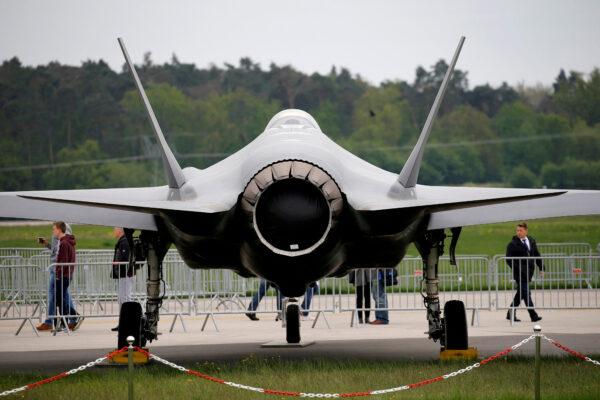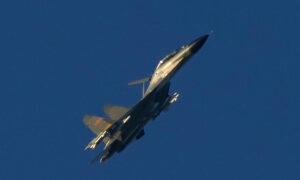“The CCP often uses reverse engineering, and their innovation is limited,” said a Taiwanese military expert.
China’s J-35 fighter jet is ready for launch from a Chinese aircraft carrier and is capable of fighting the U.S. military’s F-35, according to recent Chinese media reports, as tensions continue to rise over the Taiwan Strait.
However, analysts pointed out that the F-35 has absolute advantages in stealth capability, avionics, engines, and other performance factors over the J-35. The two are not even on the same level.
Chinese media outlets including Tencent reported that during the third sea trial of China’s third aircraft carrier the Fujian earlier this month, a “green version of the J-35” was carried on board and may have been ready to launch in real time.
According to Chinese media reports, the fuselage and external configuration of this aircraft are very similar to the F-35, and the fighter is designed to compete with the U.S. military’s F-35.
The J-35 was developed by the state-owned Shenyang Aircraft Industry Group of China. It was first publicly unveiled at the Zhuhai Air Show in 2014 with the codenamed FC-31 “Falcon.” In mainland Chinese media reports, this aircraft is often considered to be China’s next-generation aircraft carrier-based aircraft and is called J-35.
Sheu Jyh-Shyang, assistant researcher at the Institute of Chinese Political, Military, and Operational Concepts at Taiwan’s Institute for National Defense and Security Research, told The Epoch Times, “What we know is that the CCP [Chinese Communist Party] often uses reverse engineering, and their innovation is limited. The PLA’s main fighter jets, from the J-11 series to the J-16, are mostly imitations and reverse engineering of the Russian Su-27 and Su-30, with few original parts. Because building an aircraft from start to finish is obviously not that easy for the CCP’s current aerospace industry,” using the acronym for the CCP’s military the People’s Liberation Army.
Retired Maj. Gen. Yu Tsung-chi in Taiwan, an adviser to the Formosa Republican Association, told The Epoch Times that the CCP’s military strategic thinking is that it wants to develop whatever weapons platforms the United States has, “but it does not have the research foundation or R&D capabilities, so of course the only option is to steal Western technology.”
“The key is that stealing technology can only obtain technology at the time of the theft, but the U.S. military technology is constantly improving and making breakthroughs. The subsequent performance is constantly improving, which the CCP cannot imitate. In addition, products manufactured by imitation or theft are almost impossible to surpass the performance of the original design in all aspects,” Mr. Yu said.
Shen Ming-shih, research fellow and director of the Division of National Security Research at Taiwan’s Institute for National Defense and Security Research, told The Epoch Times that the CCP wants to steal or introduce a lot of military technology from the United States through various means. “For example, the J-20 copied the U.S. F-22, the J-31 copied the F-35, and even the heavy bomber H-20 obviously copied the B2.”
“Because it has no way to conduct independent research and development, the CCP’s own basic science, materials science, and the development of systems or combat systems are affected,” Mr Shen said.

“Although it can copy and learn from other countries’ blueprints, the materials or metals used by others are very good, and its own materials and metals are not good enough. In addition, in terms of system integration, although it can imitate others’ systems, the integration effect may not be as good as others. So when copying others’ things, the appearance may be very similar, but the actual combat power may only be 70 percent to 80 percent [of the original].”
F-35 Advantages
Compared with the J-35, the most significant advantage of the F-35 is stealth technology. The F-35 design uses radar-absorbing materials and a unique fuselage shape, which greatly reduces the radar cross-sectional area, according to the experts and public records.
Mr. Sheu said that in terms of stealth, U.S. fighter jets usually use paint to assist in improving their stealth capabilities. “The United States is the only country in the world that has this capability. It is still unknown how much of this technology the CCP has acquired.”

Another key advantage of the F-35 is its advanced sensors and avionics. It is equipped with an AN/APG-81 AESA radar, which provides excellent tracking, targeting, and electronic warfare capabilities. The distributed aperture system (DAS) provides the F-35 with 360-degree situational awareness, allowing pilots to detect and respond to threats from any direction. The electro-optical targeting system (EOTS) integrates targeting, infrared search and tracking, and laser designation functions. This comprehensive sensor fusion system exceeds the capabilities of China’s J series fighter jets and provides F-35 pilots with unparalleled situational awareness and combat power.
Mr. Yu said that the data released by the CCP said that J-35’s detection range is comparable to that of the fifth-generation fighter jets and Taiwan’s S6V. “However, the difference is that the numbers released by the West are actual combat parameters, while the data released by the CCP are experimental parameters, and there’s a big gap between the two.”
Aircraft engines have always been a weak point of China’s aviation industry. The CCP’s military aircraft engines have been reported to have insufficient thrust and a short lifespan. This is also an important target of the CCP’s technology theft for its goal of “Made in China 2025,” according to the experts.
Mr. Yu said that the biggest problem with the China-made fighter jets is that the aircraft’s engine thrust is seriously insufficient. In addition, the life of its engine is probably less than one-third of that of the U.S. military engine.
He added, “Another problem is that the number of qualified pilots for the CCP’s new fighter jets is seriously insufficient, which is also the main reason for the outside world’s continued doubts about the air combat capability of its new generation of fighter jets. Because the operation of software and the training of fifth-generation fighter pilots are very difficult.”
Song Tang and Yi Ru contributed to this report.
Source link








































Add comment